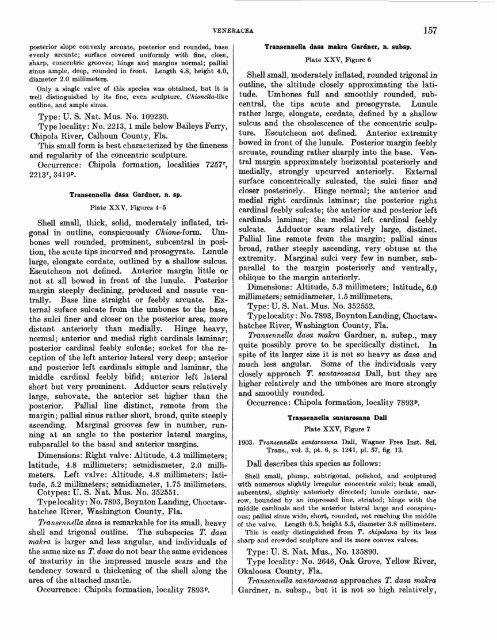the molluscan fauna of the alum bluff group of florida
the molluscan fauna of the alum bluff group of florida
the molluscan fauna of the alum bluff group of florida
You also want an ePaper? Increase the reach of your titles
YUMPU automatically turns print PDFs into web optimized ePapers that Google loves.
posterior slope convexly arcuate, posterior end rounded, base<br />
evenly arcuate; surface covered uniformly with fine, close,<br />
sharp, concentric grooves; hinge and margins normal; pallial<br />
sinus ample, deep, rounded in front. Length 4.8, height 4.0,<br />
diameter 2.0 millimeters.<br />
Only a single valve <strong>of</strong> this species was obtained, but it is<br />
well distinguished by its fine, even sculpture, CMoneMa-like<br />
outline, and ample sinus.<br />
Type: U. S. Nat. Mus. No. 109230.<br />
Type locality: No. 2213, 1 mile below Baileys Ferry,<br />
Chipola River, Calhoun County, Fla.<br />
This small form is best characterized by <strong>the</strong> fineness<br />
and regularity <strong>of</strong> <strong>the</strong> concentric sculpture.<br />
Occurrence: Chipola formation, localities 7257r,<br />
2213 r , 3419 p.<br />
Transennella dasa Gardner, n. sp.<br />
Plate XXV, Figures 4-5<br />
Shell small, thick, solid, moderately inflated, tri<br />
gonal in outline, conspicuously Chione-form. Um-<br />
bones well rounded, prominent, subcentral in posi<br />
tion, <strong>the</strong> acute tips incurved and prosogyrate. Lunule<br />
large, elongate cordate, outlined by a shallow sulcus.<br />
Escutcheon not defined. Anterior margin little or<br />
not at all bowed in front <strong>of</strong> <strong>the</strong> lunule. Posterior<br />
margin steeply declining, produced and nasute ven-<br />
trally. Base line straight or feebly arcuate. Ex<br />
ternal suface sulcate from <strong>the</strong> umbones to <strong>the</strong> base,<br />
<strong>the</strong> sulci finer and closer on <strong>the</strong> posterior area, more<br />
distant anteriorly than medially. Hinge heavy,<br />
normal; anterior and medial right cardinals laminar;<br />
posterior cardinal feebly sulcate; socket for <strong>the</strong> re<br />
ception <strong>of</strong> <strong>the</strong> left anterior lateral very deep; anterior<br />
and posterior left cardinals simple and laminar, <strong>the</strong><br />
middle cardinal feebly bifid; anterior left lateral<br />
short but very prominent. Adductor scars relatively<br />
large, subovate, <strong>the</strong> anterior set higher than <strong>the</strong><br />
posterior. Pallial line distinct, remote from <strong>the</strong><br />
margin; pallial sinus ra<strong>the</strong>r short, broad, quite steeply<br />
ascending. Marginal grooves few in number, run<br />
ning at an angle to <strong>the</strong> posterior lateral margins,<br />
subparallel to <strong>the</strong> basal and anterior margins.<br />
Dimensions: Right valve: Altitude, 4.3 millimeters;<br />
latitude, 4.8 millimeters; semidiameter, 2.0 milli<br />
meters. Left valve: Altitude, 4.8 millimeters; lati<br />
tude, 5.2 millimeters; semidiameter, 1.75 millimeters.<br />
Cotypes: U. S. Nat. Mus. No. 352551.<br />
Type locality: No. 7893, Boynton Landing, Choctaw-<br />
hatchee River, Washington County, Fla.<br />
Transennella dasa is remarkable for its small, heavy<br />
shell and trigonal outline. The subspecies T. dasa<br />
makra is larger and less angular, and individuals <strong>of</strong><br />
<strong>the</strong> same size as T. dasa do not bear <strong>the</strong> same evidences<br />
<strong>of</strong> maturity in <strong>the</strong> impressed muscle scars and <strong>the</strong><br />
tendency toward a thickening <strong>of</strong> <strong>the</strong> shell along <strong>the</strong><br />
area <strong>of</strong> <strong>the</strong> attached mantle.<br />
Occurrence: Chipola formation, locality 7893 p.<br />
VENERACEA 157<br />
Transennella dasa makra Gardner, n. subsp.<br />
Plate XXV, Figure 6<br />
Shell small, moderately inflated, rounded trigonal in<br />
outline, <strong>the</strong> altitude closely approximating <strong>the</strong> lati<br />
tude. Umbones full and smoothly rounded, sub-<br />
central, <strong>the</strong> tips acute and prosogyrate. Lunule<br />
ra<strong>the</strong>r large, elongate, cordate, defined by a shallow<br />
sulcus and <strong>the</strong> obsolescence <strong>of</strong> <strong>the</strong> concentric sculp<br />
ture. Escutcheon not defined. Anterior extremity<br />
bowed in front <strong>of</strong> <strong>the</strong> lunule. Posterior margin feebly<br />
arcuate, rounding ra<strong>the</strong>r sharply into <strong>the</strong> base. Ven<br />
tral margin approximately horizontal posteriorly and<br />
medially, strongly upcurved anteriorly. External<br />
surface concentrically sulcated, <strong>the</strong> sulci finer and<br />
closer posteriorly. Hinge normal; <strong>the</strong> anterior and<br />
medial right cardinals laminar; <strong>the</strong> posterior right<br />
cardinal feebly sulcate; <strong>the</strong> anterior and posterior left<br />
cardinals laminar; <strong>the</strong> medial left cardinal feebly<br />
sulcate. Adductor scars relatively large, distinct.<br />
Pallial line remote from <strong>the</strong> margin; pallial sinus<br />
broad, ra<strong>the</strong>r steeply ascending, very obtuse at <strong>the</strong><br />
extremity. Marginal sulci very few in number, sub-<br />
parallel to <strong>the</strong> margin posteriorly and ventrally,<br />
oblique to <strong>the</strong> margin anteriorly.<br />
Dimensions: Altitude, 5.3 millimeters; latitude, 6.0<br />
millimeters; semidiameter, 1.5 millimeters.<br />
Type: U. S. Nat. Mus. No. 352552.<br />
Type locality: No. 7893, Boynton Landing, Choctaw-<br />
hatchee River, Washington County, Fla.<br />
Transennella dasa makra Gardner, n. subsp., may<br />
quite possibly prove to be specifically distinct. In<br />
spite <strong>of</strong> its larger size it is not so heavy as dasa and<br />
much less angular. Some <strong>of</strong> <strong>the</strong> individuals very<br />
closely approach T. santarosana Dall, but <strong>the</strong>y are<br />
higher relatively and <strong>the</strong> umbones are more strongly<br />
and smoothly rounded.<br />
Occurrence: Chipola formation, locality 7893 p.<br />
Transennella santarosana Dall<br />
Plate XXV, Figure 7<br />
1903. Transennella santarosana Dall, Wagner Free Inst. Sci.<br />
Trans., vol. 3, pt. 6, p. 1241, pi. 57, fig. 13.<br />
Dall describes this species as follows:<br />
Shell small, plump, subtrigonal, polished, and sculptured<br />
with numerous slightly irregular concentric sulci; beak small,<br />
subcentral, slightly anteriorly directed; lunule cordate, nar<br />
row, bounded by an impressed line, striated; hinge with <strong>the</strong><br />
middle cardinals and <strong>the</strong> anterior lateral large and conspicu<br />
ous; pallial sinus wide, short, rounded, not reaching <strong>the</strong> middle<br />
<strong>of</strong> <strong>the</strong> valve. Length 6.5, "height 5.5, diameter 3.8 millimeters.<br />
This is easily distinguished from T. chipolana by its less<br />
sharp and crowded sculpture and its more convex valves.<br />
Type: U. S. Nat. Mus., No. 135890.<br />
Type locality: No. 2646, Oak Grove, Yellow River,<br />
Okaloosa County, Fla.<br />
Transennella santarosana approaches T. dasa makra<br />
Gardner, n. subsp., but it is not so high relatively,

















